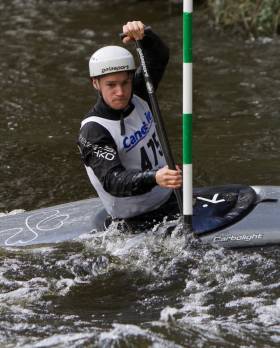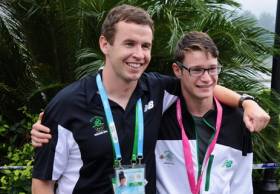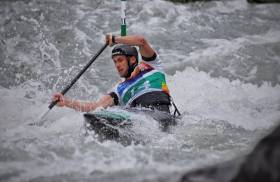Displaying items by tag: Robert Hendrick
Robert Hendrick Wins Ireland a Canoe Slalom Place at 2024 Olympic Games
Irish Olympic canoeist Robert Hendrick has accomplished an impressive feat by qualifying his country for the Paris 2024 Olympic Games in Canoe Slalom, a moment of immense pride for the Irish paddlesports community.
He demonstrated skill and composure in the semi-final round of the World Championships, securing 16th place and booking a spot for Ireland on the C1 Men start line for next year's Games.
During the semi-finals, Liam Jegou, a Tokyo Olympian, participated in the canoe slalom race. Despite commendable skill, he fell to the narrow margins in canoe slalom and lost valuable time towards the end, finishing 30th.
In the meantime, the Irish K1 Men are still in the running for Olympic qualification, with Noel Hendrick set to participate in Saturday's semi-final. If he finishes in the top 15, it will secure a quota spot for the Paris Games, keeping Ireland's hopes alive for the event.
Jegou Places Well in Irish Selection Races at British Open
#Canoeing: Liam Jegou shone in the Irish Selection Races at the canoe slalom British Open at Lee Valley. The 23-year-old paddler was the fastest C1 competitor in the two runs on Saturday and again on Sunday. On the two Sunday runs, Robert Hendrick, who qualified the C1 for Tokyo, had a 50 second penalty for missing gate 12 in the first run and gate five in the second.
The races were part of the process of choosing the Ireland C1 paddler for Tokyo. There is an appeals window, and an announcement of the nominee will not be made until later.
Hendrick Qualifies Ireland for Olympic Games in Canoeing
#Canoeing: Robert Hendrick qualified Ireland for an Olympic place in canoeing at the World Championships in La Seu d’Urgell in Spain this morning. Going off first in the C1 competition, the Kildare man put down a nerveless run of 95.12 seconds without a time penalty. It stood up as a fine time even as 29 more paddlers came down the course. The top 11 nations qualified for the Olympic Games and Hendrick gave Ireland 9th overall in this ranking. His personal placing of 11th saw him miss out by one place on an A Final place.
Canoe Slalom World Championships, La Seu d’Urgell, Spain (Irish interest)
Men
C1 – Semi-Final (First 11 nations qualify boat for Olympic Games; First 10 to A Final): 11 (ninth nation) R Hendrick 95.12 seconds.
Hendrick Qualifies for World Championship Semi-Finals
#Canoeing: Robert Hendrick qualified for the semi-final of the C1 (Canadian canoe) at the canoe slalom World Championships at La Seu d’Urgell today.
The Kildare man took 10th place in his second run – just inside the crucial cut-off point. Hendrick’s 99.03 seconds with no time penalties put him in 11th in the first set of results, but Italy’s Roberto Colazingari was then given a 50-second penalty for missing a gate and dropped out of the top 10. Hendrick had made it through.
Hendrick will qualify Ireland for a place in the C1 in Tokyo 2020 if he can place in the top 11 nations in the semi-finals.
Liam Jegou finished 13th, missing out on a qualification spot because of a two-second penalty for a touch on gate 11. Jake Cochrane, who was less than half a second outside qualification in the first run, did not do so well second time around and finished 49th. He missed gate five and incurred a 50-second penalty.
Canoe Slalom World Championships, La Seu d’Urgell, Spain (Irish interest)
Men
C1 – First Run (top 20 qualify directly): 26 J Cochrane 99.72, 38 R Hendrick 103.68, 46 L Jegou 106.38. SECOND RUN (top 10 to semi-finals): 10 Hendrick 99.03; 13 Jegou 99.62, 49 Cochrane 151.72
Women
K1 – First Run (top 20 qualify directly): 72 H Craig 182.68, 75 A Conlan 195.02, 76 C O’Ferrall 245.62. SECOND RUN (top 10 to semi-finals): 41 Conlan 133.13, 45 O’Ferrall 148.39, 51 Craig 174.61
Cochrane Close after First World Championship Run
#Canoeing: The first run in the men’s C1 at the canoe slalom World Championships saw Jake Cochrane come closest to qualifying for the semi-finals. Cochrane had a fast, clear run to the final gate at La Seu d’Urgell, and even a touch here still left him in the hunt for a top 20 place. His time of 99.72 eventually placed him 26th. Robert Hendrick also had just one touch – on gate 20 – and finished 38th on this run.
Liam Jegou had a disapointing run, touching four gates and placing 46th.
The second run comes later today.
Canoe Slalom World Championships, La Seu d’Urgell, Spain (Irish interest)
Men
C1 – First Run (top 20 qualify directly): 26 J Cochrane 99.72, 38 R Hendrick 103.68, 46 L Jegou 106.38.































































